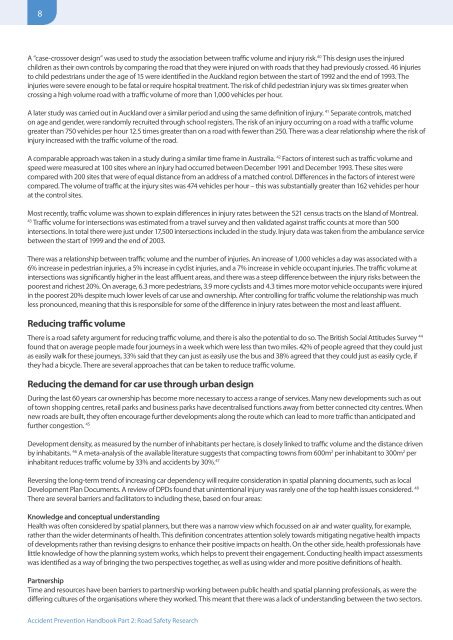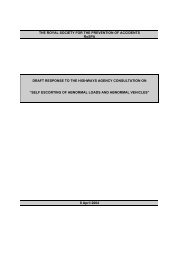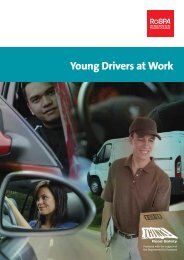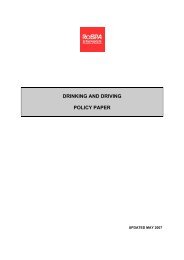Road safety policy and links to wider objectives - RoSPA
Road safety policy and links to wider objectives - RoSPA
Road safety policy and links to wider objectives - RoSPA
Create successful ePaper yourself
Turn your PDF publications into a flip-book with our unique Google optimized e-Paper software.
8<br />
A “case-crossover design” was used <strong>to</strong> study the association between traffic volume <strong>and</strong> injury risk. 40 This design uses the injured<br />
children as their own controls by comparing the road that they were injured on with roads that they had previously crossed. 46 injuries<br />
<strong>to</strong> child pedestrians under the age of 15 were identified in the Auckl<strong>and</strong> region between the start of 1992 <strong>and</strong> the end of 1993. The<br />
injuries were severe enough <strong>to</strong> be fatal or require hospital treatment. The risk of child pedestrian injury was six times greater when<br />
crossing a high volume road with a traffic volume of more than 1,000 vehicles per hour.<br />
A later study was carried out in Auckl<strong>and</strong> over a similar period <strong>and</strong> using the same definition of injury. 41 Separate controls, matched<br />
on age <strong>and</strong> gender, were r<strong>and</strong>omly recruited through school registers. The risk of an injury occurring on a road with a traffic volume<br />
greater than 750 vehicles per hour 12.5 times greater than on a road with fewer than 250. There was a clear relationship where the risk of<br />
injury increased with the traffic volume of the road.<br />
A comparable approach was taken in a study during a similar time frame in Australia. 42 Fac<strong>to</strong>rs of interest such as traffic volume <strong>and</strong><br />
speed were measured at 100 sites where an injury had occurred between December 1991 <strong>and</strong> December 1993. These sites were<br />
compared with 200 sites that were of equal distance from an address of a matched control. Differences in the fac<strong>to</strong>rs of interest were<br />
compared. The volume of traffic at the injury sites was 474 vehicles per hour – this was substantially greater than 162 vehicles per hour<br />
at the control sites.<br />
Most recently, traffic volume was shown <strong>to</strong> explain differences in injury rates between the 521 census tracts on the Isl<strong>and</strong> of Montreal.<br />
43<br />
Traffic volume for intersections was estimated from a travel survey <strong>and</strong> then validated against traffic counts at more than 500<br />
intersections. In <strong>to</strong>tal there were just under 17,500 intersections included in the study. Injury data was taken from the ambulance service<br />
between the start of 1999 <strong>and</strong> the end of 2003.<br />
There was a relationship between traffic volume <strong>and</strong> the number of injuries. An increase of 1,000 vehicles a day was associated with a<br />
6% increase in pedestrian injuries, a 5% increase in cyclist injuries, <strong>and</strong> a 7% increase in vehicle occupant injuries. The traffic volume at<br />
intersections was significantly higher in the least affluent areas, <strong>and</strong> there was a steep difference between the injury risks between the<br />
poorest <strong>and</strong> richest 20%. On average, 6.3 more pedestrians, 3.9 more cyclists <strong>and</strong> 4.3 times more mo<strong>to</strong>r vehicle occupants were injured<br />
in the poorest 20% despite much lower levels of car use <strong>and</strong> ownership. After controlling for traffic volume the relationship was much<br />
less pronounced, meaning that this is responsible for some of the difference in injury rates between the most <strong>and</strong> least affluent.<br />
Reducing traffic volume<br />
There is a road <strong>safety</strong> argument for reducing traffic volume, <strong>and</strong> there is also the potential <strong>to</strong> do so. The British Social Attitudes Survey 44<br />
found that on average people made four journeys in a week which were less than two miles. 42% of people agreed that they could just<br />
as easily walk for these journeys, 33% said that they can just as easily use the bus <strong>and</strong> 38% agreed that they could just as easily cycle, if<br />
they had a bicycle. There are several approaches that can be taken <strong>to</strong> reduce traffic volume.<br />
Reducing the dem<strong>and</strong> for car use through urban design<br />
During the last 60 years car ownership has become more necessary <strong>to</strong> access a range of services. Many new developments such as out<br />
of <strong>to</strong>wn shopping centres, retail parks <strong>and</strong> business parks have decentralised functions away from better connected city centres. When<br />
new roads are built, they often encourage further developments along the route which can lead <strong>to</strong> more traffic than anticipated <strong>and</strong><br />
further congestion. 45<br />
Development density, as measured by the number of inhabitants per hectare, is closely linked <strong>to</strong> traffic volume <strong>and</strong> the distance driven<br />
by inhabitants. 46 A meta-analysis of the available literature suggests that compacting <strong>to</strong>wns from 600m 2 per inhabitant <strong>to</strong> 300m 2 per<br />
inhabitant reduces traffic volume by 33% <strong>and</strong> accidents by 30%. 47<br />
Reversing the long-term trend of increasing car dependency will require consideration in spatial planning documents, such as local<br />
Development Plan Documents. A review of DPDs found that unintentional injury was rarely one of the <strong>to</strong>p health issues considered. 48<br />
There are several barriers <strong>and</strong> facilita<strong>to</strong>rs <strong>to</strong> including these, based on four areas:<br />
Knowledge <strong>and</strong> conceptual underst<strong>and</strong>ing<br />
Health was often considered by spatial planners, but there was a narrow view which focussed on air <strong>and</strong> water quality, for example,<br />
rather than the <strong>wider</strong> determinants of health. This definition concentrates attention solely <strong>to</strong>wards mitigating negative health impacts<br />
of developments rather than revising designs <strong>to</strong> enhance their positive impacts on health. On the other side, health professionals have<br />
little knowledge of how the planning system works, which helps <strong>to</strong> prevent their engagement. Conducting health impact assessments<br />
was identified as a way of bringing the two perspectives <strong>to</strong>gether, as well as using <strong>wider</strong> <strong>and</strong> more positive definitions of health.<br />
Partnership<br />
Time <strong>and</strong> resources have been barriers <strong>to</strong> partnership working between public health <strong>and</strong> spatial planning professionals, as were the<br />
differing cultures of the organisations where they worked. This meant that there was a lack of underst<strong>and</strong>ing between the two sec<strong>to</strong>rs.<br />
Accident Prevention H<strong>and</strong>book Part 2: <strong>Road</strong> Safety Research

















